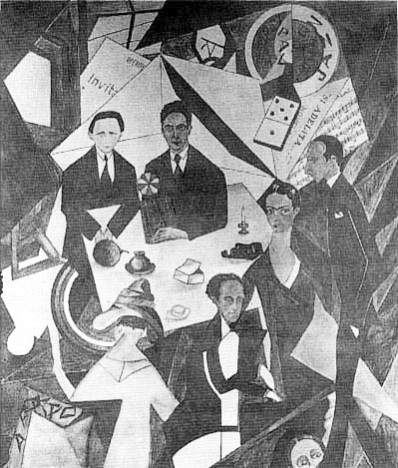If
Adelita
or The Peaked Caps
1927
"The Cachuchas" was a young people's political group that Frida joined while attending school at the Escuela Nacional Preparatoria. They were so named because of the peaked caps they wore. Frida portrayed several of the group members in this painting along with symbols related to their interests. From left to right is Alejandro Gomez Arias, boyfriend of Frida and leader of the group. Next is Miguel N. Lira, with a pinwheel in his hand, nicknamed "Chong Lee" by Frida because of his love of Chinese poetry. Next is the author Octavio Bustamante, whose book "Invitation to the Dancing" is shown above (left side). Next, Frida paints herself with a style still under the European influence. Sitting next to Frida is the composer Angel Salas, his symbol is a sheet of music (above right). In the bottom right corner is a portion of the painting "Portrait of Ruth Quintanilla" that Frida painted in 1927. And, finally, the lady with her back to the viewer is Carmen Jaime, the only other woman in the group. The remaining symbols in the painting represent the interests of the members of the group.
The people in this painting are real life people and demonstrates Kahlo's ability to capture their true likeness. The style of the painting is Frida's obscure version of "Cubism", a popular style at the time.
The alternative title of this painting: "Si Adelita..." ("If Adelita..."), is the beginning lyrics of a popular festive Mexican tune.
A priest in Mexico, who claims to be the executor of the Miguel Lira estate, claims that Frida did not paint this painting. He claims to have documented proof that Lira taught Kahlo how to paint in the "Cubist" style and that this painting was painted by Lira himself and only signed by Kahlo. Lira relatives dispute that claim saying Lira didn't even know how to paint. The priest plans to publish a "tell all" book in 2007 entitled "Frida Confesses" in which he will expose the "real truth" about Frida Kahlo.

Oil
on canvas
25 5/8" x 17 3/4"
Private Collection
Mexico
Óleo sobre lienzo
65,3 x 45,1
cm.
Colección privada
México
Si Adelita
o Los Cachuchas
1927
"Los Cachuchas" eran un grupo político de jóvenes al cual Frida se unió mientras iba a la escuela en la Escuela Nacional Preparatoria. Escogieron ese nombre debido a las gorras de pico que llevaban. Frida pintó a varios de los miembros del grupo en este retrato junto con símbolos relacionados con sus intereses. De izquierda a derecha están Alejandro Gómez Arias, novio de Frida y líder del grupo, con una bomba en sus manos. A continuación está Miguel N. Lira, con un molinete en su mano; Frida le dio el apodo de "Chong Lee" debido a su amor por la poesía china, A continuación está el autor Octavio Bustamante cuyo libro, "Invitación al dancing" se muestra arriba (en la parte izquierda). Luego aparece Frida, cuyo autorretrato todavía muestra influencia europea. Sentado al lado de Frida está el compositor Angel Salas, cuyo símbolo es una partitura (arriba a la derecha). En la esquina inferior derecha hay una porción de la pintura "Retrato de Ruth Quintanilla" que Frida pintó en 1927. Y, finalmente, la dama dando la espalda al espectador es Carmen Jaime, la otra mujer en el grupo. El resto de los símbolos en el retrato representan los diversos intereses de los miembros del grupo.
Los personajes en el cuadro son personas de verdad y demuestra la habilidad de Kahlo de capturar su aspecto. El estilo de la pintura es en la cubista versión de Frida, un estilo popular en esos años.
El titulo alternativo de este retrato: "Si Adelita…", son las primeras palabras de una canción popular mexicana. ("Si Adelita se fuera con otro/la seguiría por tierra y por mar/si por mar en un buque de guerra/si por tierra en un tren militar")
Un sacerdote en Mexico, que proclama ser el ejecutor del estado de Miguel Lira, alega que Frida no es la autora de esta pintura. El alega que tiene pruebas bien documentadas de que Lira enseñó a Kahlo a pintar en estilo "cubista" y que este retrato fue pintado por Lira y Kahlo tan solo lo firmó. Parientes de Lira contradicen estas alegaciones diciendo que Lira no tan sólo sabia pintar. El sacerdote planea publicar un libro con toda la información en 2007 llamado "Frida confiesa" en el cual expondrá la real verdad sobre Frida Kahlo.